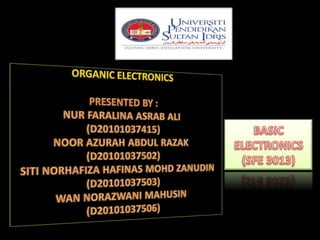Organic electronics is a branch of electronics dealing with conductive polymers and small molecules. Conductive polymers are lighter, more flexible, and less expensive than inorganic conductors, making them desirable for many applications. Significant developments include the discovery that doping polyacetylene with iodine increases its conductivity by 12 orders of magnitude, and the invention of the organic light-emitting diode and organic photovoltaic cell. Organic electronics utilize carbon-based materials and offer advantages over traditional silicon-based electronics such as lower cost, mechanical flexibility, and lower processing temperatures.


















![Organic Photovoltaic
There are a lot of material consist in organic
photovoltaic such as:
1. [6,6]-Phenyl C61 butyric acid methyl ester
2. [6,6]-Pentadeuterophenyl C61 butyric acid methyl ester
3. [6,6]-Phenyl-C61 butyric acid butyl ester
4. [6,6]-Phenyl-C61 butyric acid octyl ester
5. [60]ThPCBM
6. (6,6)-Phenyl C71 butyric acid methyl ester
7. (6,6)-Phenyl C85 butyric acid methyl ester
8. Poly[2-methoxy-5-(3’,7’-dimethyloctyloxy)1,4-
phenylenevinylene]
9. Poly[2-methoxy-5-(2-ethylhexyloxy)
1,4phenylenevinylene]
10. Poly(3-hexylthiophene-2,5-diyl)](https://image.slidesharecdn.com/organicelectronic-130701123437-phpapp02/85/Organic-electronic-19-320.jpg)
![Structure of the material in organic photovoltaic:
1. [6,6]-Phenyl C61 butyric acid methyl ester
2. [6,6]-Pentadeuterophenyl C61 butyric acid
methyl ester
3. [6,6]-Phenyl-C61 butyric acid butyl ester](https://image.slidesharecdn.com/organicelectronic-130701123437-phpapp02/85/Organic-electronic-20-320.jpg)
![4. [6,6]-Phenyl-C61 butyric acid octyl ester
5. [60]ThPCBM
6. (6,6)-Phenyl C71 butyric acid methyl ester](https://image.slidesharecdn.com/organicelectronic-130701123437-phpapp02/85/Organic-electronic-21-320.jpg)
![7. (6,6)-Phenyl C85 butyric
acid methyl ester
8. Poly[2-methoxy-5-(3’,7’-
dimethyloctyloxy)1,4-
phenylenevinylene]
9. Poly[2-methoxy-5-(2-
ethylhexyloxy)
1,4phenylenevinylene]
10. Poly(3-hexylthiophene-
2,5-diyl)](https://image.slidesharecdn.com/organicelectronic-130701123437-phpapp02/85/Organic-electronic-22-320.jpg)
































